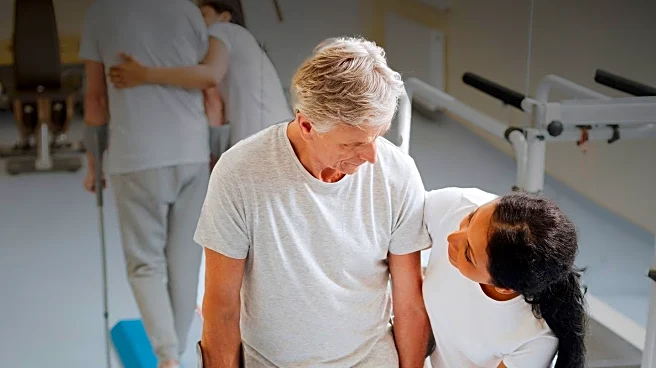What is the story about?
What's Happening?
Experts highlight exercise as a crucial treatment for osteoarthritis, the most common joint disease globally. Despite its effectiveness, many patients are not guided towards exercise by healthcare providers. Research indicates that less than half of osteoarthritis patients are referred to exercise or physiotherapy, with many receiving treatments not recommended by guidelines. Exercise is shown to protect joints, ease pain, and improve overall health by strengthening cartilage and muscles, reducing inflammation, and enhancing metabolic and hormonal functions. The disease affects the entire joint, including fluid, bone, ligaments, muscles, and nerves, making therapeutic exercise vital for comprehensive joint health.
Why It's Important?
The emphasis on exercise as a primary treatment for osteoarthritis could shift healthcare practices, reducing reliance on medication and surgery. This approach may lead to improved patient outcomes, lower healthcare costs, and enhanced quality of life for millions affected by the disease. Regular exercise not only addresses joint health but also offers benefits across various chronic conditions, potentially reducing the burden on healthcare systems. As obesity and sedentary lifestyles contribute to the rising prevalence of osteoarthritis, promoting exercise could mitigate these risk factors and slow disease progression.
What's Next?
Healthcare systems may need to reevaluate their treatment protocols to prioritize exercise and physiotherapy for osteoarthritis patients. Increased training for healthcare providers on the benefits of exercise could improve referral rates. Public health campaigns might focus on educating patients about the importance of regular physical activity in managing joint health. Research into specific exercise programs, like GLA:D®, could further refine treatment strategies and enhance patient adherence.
Beyond the Headlines
The shift towards exercise-based treatment raises ethical considerations about patient autonomy and informed consent, as patients should be fully aware of all treatment options. Culturally, this approach may challenge perceptions of aging and joint health, promoting a more active lifestyle as a norm rather than an exception. Long-term, this could influence societal attitudes towards health and wellness, encouraging proactive management of chronic conditions.
AI Generated Content
Do you find this article useful?













